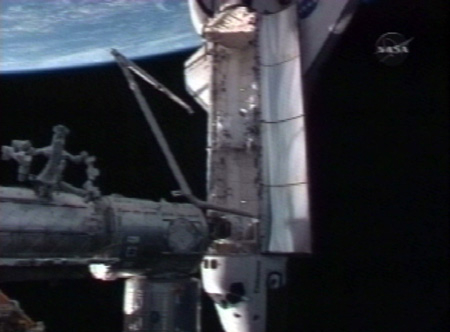This is an archive of information released in the past.
Disclaimer: It may contain broken links or outdated information. Some parts may not function in current web browsers.
*Visit https://humans-in-space.jaxa.jp/en/ for the latest information.

Mission
Flight Day 12
Aboard the International Space Station (ISS), the STS-123 Mission crew carried out the shuttle's heat shield inspection known as "late inspection" using the shuttle's robotic arm (SRMS) and the orbiter boom sensor system (OBSS). It was the first time in the shuttle's ISS assembly flight history that the late inspection was performed while being docked with the ISS.
STS-123 Mission will leave the OBSS on the ISS when returns to the ground. This is because the next ISS assembly mission, STS-124 Mission, will not carry the OBSS to make room for the mission's main payload, Kibo Pressurized Module (PM). The PM is a large module, actually the largest module among the other ISS modules, thus, when the PM is installed inside the shuttle's payload bay upon launch, enough clearance can not be assured between the PM and OBSS.
Inside of the ISS, the ISS crew relocated two science research racks installed in the Destiny laboratory, the EXPRESS-3 Rack and the Microgravity Science Glovebox (MSG) Rack, to the Columbus laboratory. The relocation of the MSG Rack was originally planned on FD14, however, the crew managed to conduct the task ahead of schedule.
Using the rest of the day, the crewmembers prepared for the mission's fifth extravehicular activity (EVA#5).
Astronaut Doi's on orbit activity
Astronauts Doi, Gorie and Johnson performed the late inspection using the shuttle's robotic arm (SRMS) and the orbiter boom sensor system (OBSS).
They scanned the reinforced carbon carbon (RCC) panels on the shuttle's wing leading edge (WLE) and nose cap with the OBSS. The data obtained during the late inspection have been downlined to the ground for analysis.
Astronaut Doi also checked the shell temperatures of the Kibo Experiment Logistics Module-Pressurized Section (ELM-PS) on the monitor of the Minimum Keep Alive Monitor (MKAM).
Before going to sleep, he reviewed the EVA#5 procedures along with the other crewmembers.
For further information, please refer to the NASA STS-123 Mission Status Report
*All times are Japan Standard Time (JST)
| Copyright 2007 Japan Aerospace Exploration Agency | Site Policy |
